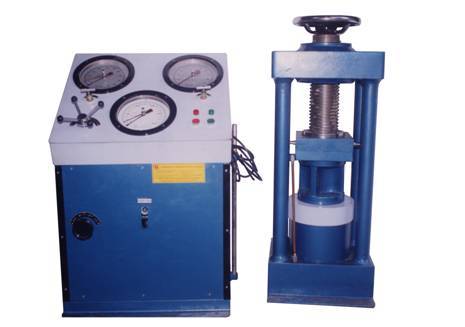Apparatus
The apparatus for the standard test shall consist of the following :
- A 15-cm diameter open-ended steel cylinder, with plunger and base-plate, of the general form and dimensions shown in Fig.
The surfaces in contact with the aggregate shall be machined and case-hardened or otherwise treated so as to have a diamond (VI-l)
pyramid hardness number of not less than 650 VII.
- A straight metal tamping rod of circular cross-section 16 mm in diameter and 45 to 60 cm long, rounded at one end.
- A balance of capacity 3 kg, readable and accurate to one gram.
- IS Sieves of sizes 12.5,lO and 2.36 mm.
- A compression testing machine capable of applying a load of 46 tonnes and which can be operated to give a uniform rate of loading
so that the maximum load is reached in 10 minutes. The machine may be used with or without a spherical seating.
- For measuring the sample, cylindrical metal measure of sufficient rigidity to retain its form under rough usage and of the following
internal dimensions:
- Diameter: 11.5 cm
- Height: 18.0 cm

Compression Testing Machine
Impact Testing Machine
Preparation of the Test Sample
The material for the standard test shall consist of aggregate passing a 12.5-mm IS Sieve and retained on a 10-mm IS Sieve,
and shall be thoroughly separated on these sieves before testing.
For other sizes, the material shall be separated on the appropriate sieves given in below Table
Table: Details of Aggregate Crushing Test for Non-Standard Sizes of Aggregates
| Sr. |
Niminal Sizes(IS Sieves) |
Diameter of Cylinder to be Used (cm) |
Size of IS Seive for Separating Fines |
| Passing through (mm) |
Retained on (mm) |
| 1. |
25 |
20 |
15.0 |
4.75 mm |
| 2. |
20 |
12.5 |
15.0 |
3.35 mm |
| 3. |
10 |
6.3 |
15.0 to 7.5 |
1.70 mm |
| 4. |
6.3 |
4.75 |
15.0 to 7.5 |
1.18 mm |
| 5. |
4.75 |
3.35 |
15.0 to 7.5 |
850 μm |
| 6. |
3.35 |
2.36 |
15.0 to 7.5 |
600 μm |
Note:
About 6.5 kg of natural aggregate is required to provide the two test samples for the 15-cm cylinder, or about 1 kg for the 7.5-cm cylinder.
- The aggregate shall be tested in a surface-dry condition. If dried by heating, the period of drying shall not exceed four hours, the temperature
shall be 100 to 110°C and the aggregate shall be cooled to room temperature before testing.
- The quantity of aggregate shall be such that the depth of material in the cylinder, after tamping as described in step 3, shall be 10 cm.
- The appropriate quantity may be found conveniently by filling the cylindrical measure in three layers of approximately equal depth,
each layer being tamped 25 times with the rounded end of the tamping rod and finally levelled off, using the tamping rod as a straight-edge.
- The weight of material comprising the test sample shall be determined (Weight A) and the same weight of sample shall be taken for the repeat test.
Test Procedure
The cylinder of the test apparatus shall be put in position on the base-plate and the test sample added in thirds, each third being subjected
to 25 strokes from the tamping rod. The surface of the aggregate shall be carefully levelled and the plunger inserted so that it rests
horizontally on this surface, care being taken to ensure that the plunger does not jam in the cylinder.
- The apparatus, with the test sample and plunger in position, shall then be placed between the platens of the testing machine and
loaded at as uniform a rate as possible so that the total load is reached in 10 minutes. The total load shall be 40 tonnes.
- The load shall be released and the whole of the material removed from the cylinder and sieved on a 2.36-mm IS Sieve for the standard test,
or the appropriate sieve given in above Table. The fraction passing the sieve shall be weighed (Weight B)
In all of these operations, care shall be taken to avoid loss of the fines. Two tests shall be made.
Calculate Aggregate Crushing Value
The ratio of the weight of fines formed to the total sample weight in each test shall be expressed as a percentage, the result being recorded to the first decimal place:
Aggregate Crushing Value =
Where,
- WA is weight of surface-dry sample
- WB is weight of fraction passing the appropriate sieve
Reporting of Results
The mean of the two results shall be reported to the nearest whole number as the ‘aggregate crushing value’ of the size of material tested.